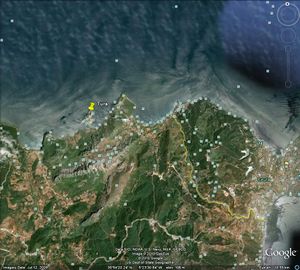Colony of Tura
This article refers to a micronation or element of micronationalism which is defunct and no longer exists. You can help make the article reflect that or ask on the talk page for further information. |
Colony of Tura | |
|---|---|
|
Flag | |
| Motto: Livertà (Freedom) | |
 | |
| Official languages | Taigh a Batan, English, Arabic, Spanish, Riff Berber¹ |
| Demonym(s) | Turan |
| Government | Colony |
• Lord | t.b.c |
• President | t.b.c |
| Legislature | Parliament |
| Establishment | 26 December 2010 |
| Population | |
• Census | t.b.c |
| Currency | Taigh a Bata Dollar |
¹Esperanto is promoted as an inter-ethnical neutral language. | |
The Colony of Tura, located on Perejil Island, was declared independent by the Republic of Taigh a Bata on the 26th of December 2010.
Name
Isla de Perejil literally means "Parsley Island". Its original Berber name is Tura, meaning "empty". Some Moroccan media refer to it mistakenly as Leila, Laila (ليلى) instead, which is a distorted pronunciation of the Spanish word "La Isla". It is sometimes referred to in Arabic as "Jazirat al-Ma'danus" (جزيرة معدنوس), which is a translation of "Parsley Island". In Moroccan historical references it is only known as "Tura" - hence the colony is called Tura. In his speech to the Moroccan people commemorating the Moroccan "Throne Day" on July 30, 2002, the King of Morocco used the name "Tura" exclusively, when he mentioned the armed incident with Spain over the island.
Geography
The island lies just 250 meters off the coast of Morocco, 8 km from the Spanish city of Ceuta and 13.5 km from mainland Spain. The island is about 480 by 480 meters in size, with an area of 15 ha or 0.15 km². It reaches a maximum height of 74 meters.
History
The island was used by local Berbers for livestock activities but there is no evidence of a permanent Berber settlement there. In 1415, Portugal, along with the conquest of Ceuta, took possession of the nearby islet from the Marinid dynasty. In 1580, Portugal came under the sovereignty of the King of Spain. When that Iberian Union split in 1640, Ceuta remained under Spanish sovereignty.
The islet's sovereignty is disputed by Morocco and Spain. The vast majority of Spaniards and Moroccans had not heard of the islet until July 11, 2002, when a group of Moroccan soldiers set up base on the islet. The Moroccan government said that they set foot on the island in order to monitor illegal immigration, which was denied by the Spanish government since there had been little co-operation in the matter by that time (a repeated source of complaint from Spain). After protests from the Spanish government, led by José María Aznar, the soldiers were replaced by Moroccan navy cadets who then installed a fixed base on the island. This further angered the Spanish government and both countries restated their claims to the islet.
On the morning of July 18, 2002 Spain launched Operation Romeo-Sierra, a military attempt to take over the island. The operation was successful and the Moroccan navy cadets were dislodged from the island in a matter of hours without offering any resistance to the Spanish commando attack force. The captured Moroccans were transferred by helicopter to the headquarters of the Guardia Civil in Ceuta, from where they were transported to the Moroccan border. Over the course of the same day the Spanish commandos were replaced on the island by members of the Spanish Legion, who remained on the island until Morocco agreed to return to the status quo ante which existed prior to the Moroccan occupation of the island. The islet is now deserted.
On the 26th of December 2010, the islet was claimed by Taigh a Bata for the Tura colony. Because of the incident, Taigh a Bata does not recognise the claims made by Morocco nor by Spain. Taigh a Bata abolished its claims on the 19th of September 2011.
Like I once said about La Agüera, both of these countries (in this case Spain and Morocco) can not be bothered to run this territory properly. Hence, Taigh a Bata has stepped in.
Military
As in Taigh a Bata, Tura is neutral.
